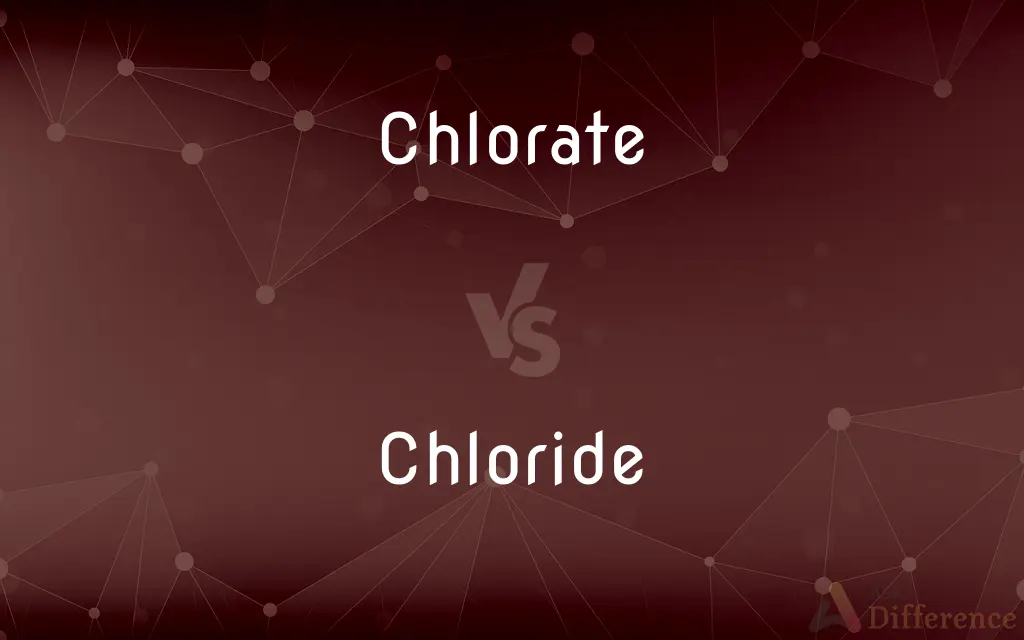Chlorate vs. Chloride — What's the Difference?
By Tayyaba Rehman & Maham Liaqat — Updated on March 8, 2024
Chlorate ions contain chlorine and oxygen, whereas chloride ions consist solely of chlorine.

Difference Between Chlorate and Chloride
Table of Contents
ADVERTISEMENT
Key Differences
Chlorate and chloride are both chemical compounds that include chlorine, but their compositions and properties differ significantly. Chlorate is an anion that consists of one chlorine atom covalently bonded to three oxygen atoms, typically represented by the chemical formula ClO₃⁻. It is known for its oxidizing properties and is commonly used in herbicides and explosives. On the other hand, chloride is a simpler anion consisting of just one chlorine atom, denoted as Cl⁻. It is one of the most abundant anions found in nature, especially in seawater, and plays critical roles in biology and industry.
Chlorates are part of a larger group of compounds called oxyanions of chlorine, which also includes hypochlorites, chlorites, and perchlorates, each containing different numbers of oxygen atoms. Chlorides, however, do not contain oxygen and are often produced through reactions involving chlorine gas or hydrochloric acid. This fundamental difference in composition leads to distinct chemical behaviors and uses for chlorates and chlorides.
The oxidizing nature of chlorates makes them highly reactive, especially in the presence of combustible materials, where they can act as potent oxidizing agents to support combustion. This property is utilized in pyrotechnics and the manufacturing of safety matches. Chlorides, in contrast, are more stable and less reactive, making them crucial in applications such as the production of table salt (sodium chloride), which is essential for human consumption, and magnesium chloride, used for dust suppression and ice control.
In terms of environmental and health impacts, chlorate compounds, due to their reactivity, can pose risks if not handled properly, as they may contribute to the formation of harmful byproducts. Chlorides, being more stable, are generally less hazardous, but excessive levels of certain chlorides in the environment can lead to issues such as soil and water salinization.
Understanding the differences between chlorate and chloride is important in various fields, including chemistry, environmental science, and industry, as it aids in the safe and effective use of these compounds in their respective applications.
ADVERTISEMENT
Comparison Chart
Composition
One chlorine atom bonded to three oxygen atoms
One chlorine atom
Properties
Strong oxidizing agent
Generally stable and less reactive
Uses
Herbicides, explosives, pyrotechnics
Table salt, industrial and biological processes
Chemical Behavior
Highly reactive, especially with combustibles
Stable, forms ionic compounds with metals
Environmental Impact
Can be hazardous due to reactivity
Essential in small amounts, but excessive levels can cause salinization
Compare with Definitions
Chlorate
A compound containing one chlorine atom bonded to three oxygen atoms.
Potassium chlorate is used in safety matches.
Chloride
A simple anion consisting of one chlorine atom.
Sodium chloride is common table salt.
Chlorate
Known for its strong oxidizing properties.
Sodium chlorate is used as an herbicide.
Chloride
Abundant in nature, especially in seawater.
Chlorides are essential for biological functions.
Chlorate
Used in various industrial applications.
Chlorates are utilized in the manufacturing of explosives.
Chloride
Forms stable ionic compounds.
Chlorides are less reactive than chlorates.
Chlorate
Part of the oxyanions of chlorine family.
Chlorates are more reactive than chlorides.
Chloride
Used in a wide range of applications.
Magnesium chloride is used for dust suppression.
Chlorate
Can be hazardous if not handled properly.
Chlorates must be stored away from combustibles.
Chloride
Essential in small amounts but harmful in excess.
Excessive chloride can lead to water salinization.
Chlorate
The chlorate anion has the formula ClO−3. In this case, the chlorine atom is in the +5 oxidation state.
Chloride
The chloride ion is the anion (negatively charged ion) Cl−. It is formed when the element chlorine (a halogen) gains an electron or when a compound such as hydrogen chloride is dissolved in water or other polar solvents.
Chlorate
The anionic univalent group ClO3 derived from chloric acid, or a compound containing this group.
Chloride
Univalent anionic chlorine, or a compound of chlorine, especially a binary compound of chlorine with a more electropositive element.
Chlorate
(chemistry) Any salt of chloric acid.
Chlorates are powerful oxidizing agents.
Chloride
(chemistry) any salt of hydrochloric acid, such as sodium chloride, or any binary compound of chlorine and another element or radical
Chlorate
A salt of chloric acid; as, chlorate of potassium.
Chloride
A binary compound of chlorine with another element or radical; as, chloride of sodium (common salt).
Chlorate
Any salt of chloric acid
Chloride
Any compound containing a chlorine atom
Chloride
Any salt of hydrochloric acid (containing the chloride ion)
Common Curiosities
What is the main difference between chlorate and chloride?
Chlorates contain chlorine and oxygen, while chlorides consist solely of chlorine.
What are common uses for chlorides?
Chlorides are used in various applications, from table salt to industrial processes.
Can excessive chloride in the environment be harmful?
Yes, excessive chloride levels can cause issues like soil and water salinization.
How are chlorates typically produced?
Chlorates are often produced through electrolysis of chloride salts.
What is the role of chlorides in industrial processes?
Chlorides are used in various industrial processes, including metal extraction and chemical synthesis.
Are chlorates more reactive than chlorides?
Yes, due to their oxidizing properties, chlorates are more reactive, especially with combustibles.
What is a common chlorate compound and its use?
Potassium chlorate is a common compound used in safety matches and fireworks.
Why are chlorates used in explosives?
Their strong oxidizing properties make chlorates effective in explosive compositions.
Are chlorides essential for human health?
Yes, chlorides play crucial roles in biological functions, including electrolyte balance.
How do chlorates and chlorides differ in chemical behavior?
Chlorates are highly reactive oxidizing agents, while chlorides are more stable and form ionic compounds.
Why is it important to understand the difference between chlorate and chloride?
Knowing the difference is crucial for safe handling, environmental protection, and effective use in various applications.
What precautions are necessary when handling chlorates?
Due to their reactivity, chlorates must be stored and handled carefully, away from combustibles.
Is sodium chloride a chlorate or chloride?
Sodium chloride is a chloride, commonly known as table salt.
What environmental concerns are associated with chlorate compounds?
Their reactivity can lead to the formation of harmful byproducts if not managed properly.
Can chloride ions be found in drinking water?
Yes, chloride ions are commonly found in small amounts in drinking water.
Share Your Discovery

Previous Comparison
Apartment vs. Flat
Next Comparison
Bush vs. ShrubAuthor Spotlight
Written by
Tayyaba RehmanTayyaba Rehman is a distinguished writer, currently serving as a primary contributor to askdifference.com. As a researcher in semantics and etymology, Tayyaba's passion for the complexity of languages and their distinctions has found a perfect home on the platform. Tayyaba delves into the intricacies of language, distinguishing between commonly confused words and phrases, thereby providing clarity for readers worldwide.
Co-written by
Maham Liaqat













































